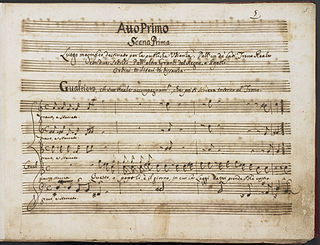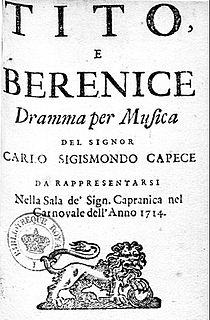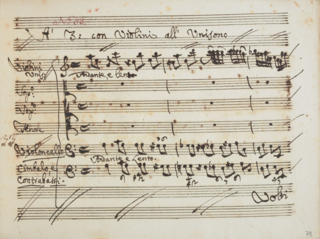
Pietro Alessandro Gaspare Scarlatti was an Italian Baroque composer, known especially for his operas and chamber cantatas. He is considered the founder of the Neapolitan school of opera. He was the father of two other composers, Domenico Scarlatti and Pietro Filippo Scarlatti.
Ignaz Jakob Holzbauer was a composer of symphonies, concertos, operas, and chamber music, and a member of the Mannheim school. His aesthetic style is in line with that of the Sturm und Drang "movement" of German art and literature.
Telemaco, ossia L'isola di Circe is an operatic dramma per musica in two acts by Christoph Willibald Gluck. The Italian libretto was written by Marco Coltellini after Carlo Sigismondo Capece's libretto for Scarlatti's 1718 opera Telemaco.

Griselda is an opera seria in three acts by the Italian composer Alessandro Scarlatti, the last of Scarlatti’s operas to survive completely today. The libretto is by Apostolo Zeno, with revisions by an anonymous author. Zeno wrote his work in 1701 and it had already been set by Pollarolo and Antonio Maria Bononcini. It is based on the story of Patient Griselda from Boccaccio's tenth day of The Decameron. Scarlatti's opera was first performed at the Teatro Capranica, Rome, in January 1721 with an all-male cast.
Carlo Francesco Pollarolo was an Italian composer, chiefly of operas. Born into a musical family, he became the cathedral organist of his home town of Brescia. In the 1680s he began composing operas for performance in nearby Venice. He wrote a total of 85 of them as well as 13 oratorios. His operatic style is noted for its development of arias accompanied by the orchestra and it shows some influence from the contemporary French opera of Jean-Baptiste Lully.
Giuseppe Scarlatti was a composer of opere serie and opere buffe. He worked in Rome from 1739 to 1741, and from 1752 to 1754 in Florence, Pisa, Lucca and Turin. From 1752 to 1754, and again from 1756 to 1759, he worked in Venice and for short periods in Milan and Barcelona. In 1760 he moved to Vienna, where he enjoyed the friendship of Christoph Willibald Gluck. "The third most important musician of his clan", it is still uncertain whether he was the nephew of Alessandro born 18 June 1723 or the nephew of Domenico born in 1718. Giuseppe Scarlatti was married to the Viennese singer Barbara Stabili who died about 1753. By 1767 he had married Antonia Lefebvre, who that year bore him a son; she died three years later. Scarlatti died intestate in 1777 in Vienna.

Giuseppe Maria Orlandini was an Italian baroque composer particularly known for his more than 40 operas and intermezzos. Highly regarded by music historians of his day like Francesco Saverio Quadrio, Jean-Benjamin de La Borde and Charles Burney, Orlandini, along with Vivaldi, is considered one of the major creators of the new style of opera that dominated the second decade of the 18th century.

L'honestà negli amori is a dramma per musica in 3 acts by composer Alessandro Scarlatti. Written in 1679-1680 when Scarlatti was 19 years old, it was his second opera. The opera uses an Italian language libretto that was written by either D F Bernini or Domenico Filippo Contini. The work premiered at the Teatro di Palazzo Bernini in Rome on 3 February 1680. The opera was performed again in 1682 in Acquaviva delle Fonti at the Palazzo De Mari with Acquaviva laureata a serenata composed by Giovanni Cesare Netti.
La Passione di Gesù Cristo is the title of a libretto by Metastasio which was repeatedly set as an azione sacra or oratorio by many composers of the late baroque, Rococo and early classical period.

Télémaque et Calypso, also Télémaque or [French: ou] Calypso, is an opera by the French composer André Cardinal Destouches, first performed at the Académie Royale de Musique on 29 November 1714. It takes the form of a tragédie en musique in a prologue and five acts.

Tito e Berenice is an opera in three acts composed by Antonio Caldara to a libretto by Carlo Sigismondo Capece. It premiered on 10 January 1714 at the Teatro Capranica in Rome. The story centers on the love affair between Berenice of Cilicia and the future Roman Emperor Titus. The libretto borrows from earlier plays on the same subject by Corneille and Racine (Bérénice), both of which premiered in 1670 and took as their starting point Suetonius's brief account of the love affair in De vita Caesarum.

The Teatro Capranica is a theatre situated at 101 Piazza Capranica in the Colonna district of Rome. Originally constructed in 1679 by the Capranica family and housed in the early Renaissance Palazzo Capranica, it was the second public theatre to open in Rome. It was the site of many premieres of Baroque operas including Caldara's Tito e Berenice, Scarlatti's Griselda, and Vivaldi's Ercole su'l Termodonte. The Capranica ceased operating as a full-scale theatre and opera house in 1881 and in 1922 was converted into a cinema. Following the closure of the cinema in 2000, it has functioned on a hire basis as a conference and performance venue.

Amor d'un'ombra e gelosia d'un'aura, also known as Narciso ("Narcissus"), is an opera in three acts composed by Domenico Scarlatti to a libretto by Carlo Sigismondo Capece. It premiered in Rome in January 1714 at the private theatre of Maria Casimira of Poland who had commissioned the work. The libretto is based on two fables from Ovid's Metamorphoses: Echo and Narcissus and Cephalus and Procris.
Giacomo Maccari was an Italian opera composer.
Ifigenia in Aulide may refer to:
Tolomeo e Alessandro, ovvero la corona disprezzata is an Italian-language opera by Domenico Scarlatti to a libretto by Carlo Sigismondo Capece which premiered in Rome on 19 January 1711 at the Palazzo Zuccari, with scenery by Filippo Juvarra. It was second of the seven operas composed by Domenico for the Polish queen Maria Casimira Sobieski, following his pastorale in three acts La Silvia of 27 January 1710.
Carlo Sigismondo Capece was an Italian dramatist and librettist. Capece was court poet to Queen Maria Casimira of Poland, who was living in exile in Rome, and is best remembered today for the libretto of La resurrezione a sacred oratorio by George Frideric Handel. He also provided the Libretto for operas including Domenico Scarlatti's Tolomeo e Alessandro (1711) and Ifigenia in Aulide (1714), as well as Caldara's Tito e Berenice (1714).
Lukas Hemleb is a German director of plays and operas, scenic designer, and librettist.

Carlo re d'Allemagna is a three-act dramma per musica by Italian composer Alessandro Scarlatti to a libretto by Giuseppe Papis, after Francesco Silvani, premiered at the Teatro San Bartolomeo of Naples on 26 or 30 January 1716. This is the composer's 79th opera out of 114 composed.









